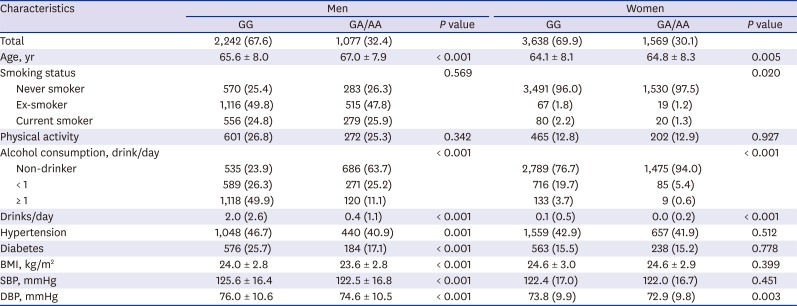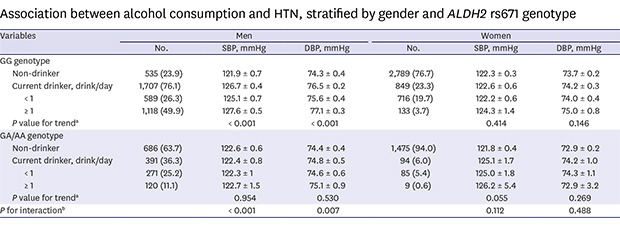1. Forouzanfar MH, Liu P, Roth GA, Ng M, Biryukov S, Marczak L, et al. Global burden of hypertension and systolic blood pressure of at least 110 to 115 mm hg, 1990–2015. JAMA. 2017; 317(2):165–182. PMID:
28097354.
2. Effects of weight loss and sodium reduction intervention on blood pressure and hypertension incidence in overweight people with high-normal blood pressure. The trials of hypertension prevention, phase II. The trials of hypertension prevention collaborative research group. Arch Intern Med. 1997; 157(6):657–667. PMID:
9080920.
3. Whelton SP, Chin A, Xin X, He J. Effect of aerobic exercise on blood pressure: a meta-analysis of randomized, controlled trials. Ann Intern Med. 2002; 136(7):493–503. PMID:
11926784.

4. Roerecke M, Kaczorowski J, Tobe SW, Gmel G, Hasan OSM, Rehm J. The effect of a reduction in alcohol consumption on blood pressure: a systematic review and meta-analysis. Lancet Public Health. 2017; 2(2):e108–20. PMID:
29253389.

5. Seitz HK, Mueller S. Alcohol and cancer. In : Verster JC, Brady K, Galanter M, Conrod P, editors. Drug Abuse and Addiction in Medical Illness: Causes, Consequences and Treatment. New York, NY: Springer;2012. p. 431–441.
6. Maejima R, Iijima K, Kaihovaara P, Hatta W, Koike T, Imatani A, et al. Effects of ALDH2 genotype, PPI treatment and L-cysteine on carcinogenic acetaldehyde in gastric juice and saliva after intragastric alcohol administration. PLoS One. 2015; 10(4):e0120397. PMID:
25831092.

7. Yokoyama A, Tsutsumi E, Imazeki H, Suwa Y, Nakamura C, Mizukami T, et al. Salivary acetaldehyde concentration according to alcoholic beverage consumed and aldehyde dehydrogenase-2 genotype. Alcohol Clin Exp Res. 2008; 32(9):1607–1614. PMID:
18616675.

8. Quillen EE, Chen XD, Almasy L, Yang F, He H, Li X, et al. ALDH2 is associated to alcohol dependence and is the major genetic determinant of “daily maximum drinks” in a GWAS study of an isolated rural Chinese sample. Am J Med Genet B Neuropsychiatr Genet. 2014; 165B(2):103–110. PMID:
24277619.
9. Cho Y, Kwak S, Lewis SJ, Wade KH, Relton CL, Smith GD, et al. Exploring the utility of alcohol flushing as an instrumental variable for alcohol intake in Koreans. Sci Rep. 2018; 8(1):458. PMID:
29323248.

10. Takeuchi F, Isono M, Nabika T, Katsuya T, Sugiyama T, Yamaguchi S, et al. Confirmation of ALDH2 as a major locus of drinking behavior and of its variants regulating multiple metabolic phenotypes in a Japanese population. Circ J. 2011; 75(4):911–918. PMID:
21372407.

11. Ma C, Yu B, Zhang W, Wang W, Zhang L, Zeng Q. Associations between aldehyde dehydrogenase 2 (ALDH2) rs671 genetic polymorphisms, lifestyles and hypertension risk in Chinese Han people. Sci Rep. 2017; 7(1):11136. PMID:
28894224.

12. Isomura M, Wang T, Yamasaki M, Hasan MZ, Shiwaku K, Nabika T. Aldehyde dehydrogenase polymorphisms and blood pressure elevation in the Japanese: a cross-sectional and a longitudinal study over 20 years in the Shimane CoHRE study. Dis Markers. 2015; 2015:825435. PMID:
26185357.

13. Yokoyama A, Mizukami T, Matsui T, Yokoyama T, Kimura M, Matsushita S, et al. Genetic polymorphisms of alcohol dehydrogenase-1B and aldehyde dehydrogenase-2 and liver cirrhosis, chronic calcific pancreatitis, diabetes mellitus, and hypertension among Japanese alcoholic men. Alcohol Clin Exp Res. 2013; 37(8):1391–1401. PMID:
23550892.

14. Zhang WS, Xu L, Schooling CM, Jiang CQ, Cheng KK, Liu B, et al. Effect of alcohol and aldehyde dehydrogenase gene polymorphisms on alcohol-associated hypertension: the Guangzhou Biobank Cohort Study. Hypertens Res. 2013; 36(8):741–746. PMID:
23615284.

15. Ota M, Hisada A, Lu X, Nakashita C, Masuda S, Katoh T. Associations between aldehyde dehydrogenase 2 (ALDH2) genetic polymorphisms, drinking status, and hypertension risk in Japanese adult male workers: a case-control study. Environ Health Prev Med. 2016; 21(1):1–8. PMID:
26318866.

16. Chen L, Smith GD, Harbord RM, Lewis SJ. Alcohol intake and blood pressure: a systematic review implementing a mendelian randomization approach. PLoS Med. 2008; 5(3):e52. PMID:
18318597.

17. Kweon SS, Shin MH, Jeong SK, Nam HS, Lee YH, Park KS, et al. Cohort profile: the Namwon study and the Dong-gu Study. Int J Epidemiol. 2014; 43(2):558–567. PMID:
23505254.

18. Schisterman EF, Cole SR, Platt RW. Overadjustment bias and unnecessary adjustment in epidemiologic studies. Epidemiology. 2009; 20(4):488–495. PMID:
19525685.

19. Roerecke M, Tobe SW, Kaczorowski J, Bacon SL, Vafaei A, Hasan OS, et al. Sex-specific associations between alcohol consumption and incidence of hypertension: a systematic review and meta-analysis of cohort studies. J Am Heart Assoc. 2018; 7(13):e008202. PMID:
29950485.

20. Marchi KC, Muniz JJ, Tirapelli CR. Hypertension and chronic ethanol consumption: what do we know after a century of study? World J Cardiol. 2014; 6(5):283–294. PMID:
24944758.

21. Hellström E, Tottmar O. Acute effects of ethanol and acetaldehyde on blood pressure and heart rate in disulfiram-treated and control rats. Pharmacol Biochem Behav. 1982; 17(6):1103–1109. PMID:
7163342.










 PDF
PDF Citation
Citation Print
Print




 XML Download
XML Download